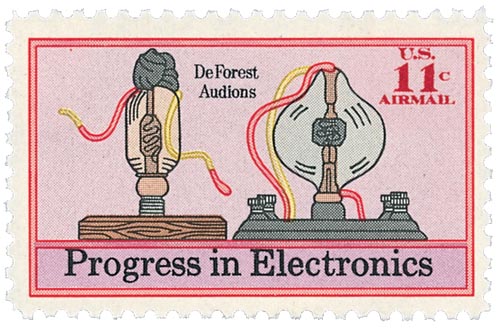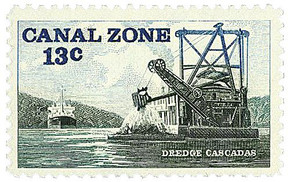
1973 11¢ DeForest Audion
Electronics Progress
First City: New York, New York
Quantity Issued: 58,705,000
Printed by: Bureau of Engraving and Printing
Printing Method: Lithographed, engraved (Giori)
Perforation: 11
Birth Of Lee De Forest
De Forest was descended from Jesse de Forest, who'd led a group of Walloon Huguenots from Europe in the 1600s. His father was a minister who hoped that his son would become a pastor, but he went to Yale's Sheffield Scientific School instead.
Early on de Forest wanted to become rich and famous and often sent his devices and puzzles to different companies, though this did little for his career. In college, his experiments often blew fuses, which caused blackouts and eventually got him expelled. He eventually returned and earned his doctorate in 1899.
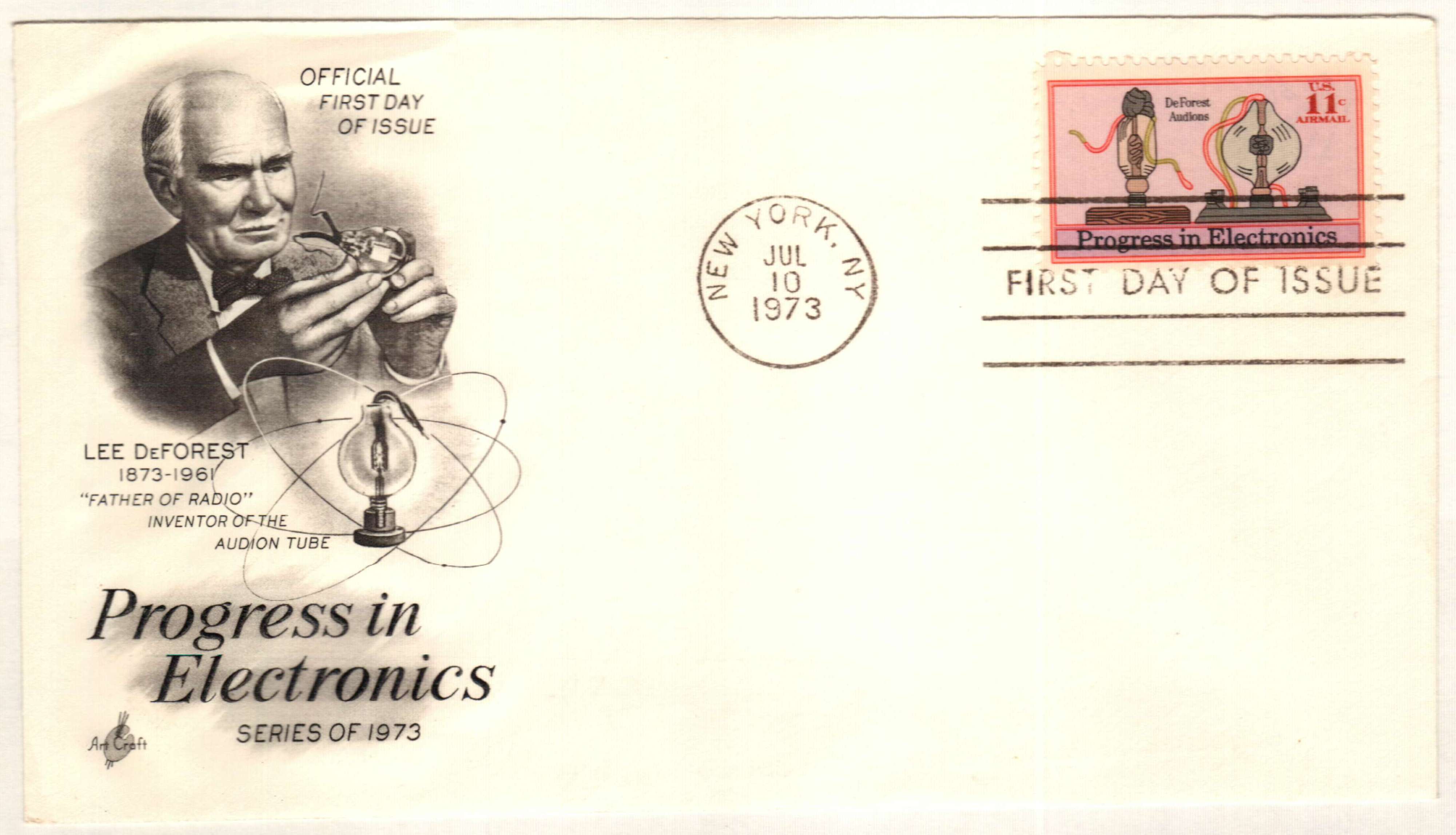 After college, de Forest worked at the Western Electric Company's telephone lab in Chicago, where he developed his first receiver and responders. After working a series of short-term jobs, he took a position as a night teacher so he could conduct experiments at the Armour Institute during the day. De Forest then went to New York to focus on his work with spark-coil transmitters.
After college, de Forest worked at the Western Electric Company's telephone lab in Chicago, where he developed his first receiver and responders. After working a series of short-term jobs, he took a position as a night teacher so he could conduct experiments at the Armour Institute during the day. De Forest then went to New York to focus on his work with spark-coil transmitters.With the aid of Abraham White, de Forest started his own company, American De Forest Wireless Telegraph. The company set up a spark transmitter on Wall Street and established stations in China that enabled journalists to report on the Russo-Japanese War. De Forest then won a gold medal for his radiotelegraph at the Louisiana Purchase Exposition in 1904. The company also built high-powered radiotelegraph stations in Florida, Panama, Cuba, and Puerto Rico.
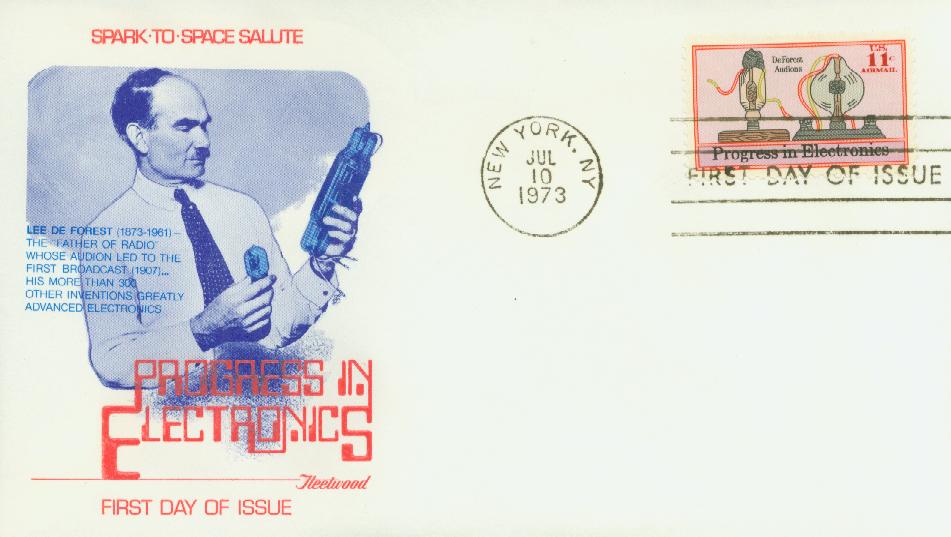 Due to conflicts with management, de Forest left the company in 1906 and formed Radio Telephone Company. He developed an arc radiotelephone during this time and made the first ship-to-shore transmissions by radiotelephone. The Navy ordered 26 of his devices for the Great White Fleet's around the world journey but removed them from the ships after their return because they were unreliable.
Due to conflicts with management, de Forest left the company in 1906 and formed Radio Telephone Company. He developed an arc radiotelephone during this time and made the first ship-to-shore transmissions by radiotelephone. The Navy ordered 26 of his devices for the Great White Fleet's around the world journey but removed them from the ships after their return because they were unreliable. De Forest's most famous invention was the Audion vacuum tube, a device for amplifying feeble electric currents. His invention resulted in the first radio broadcast in 1907, earning de Forest the name "Father of the Radio."
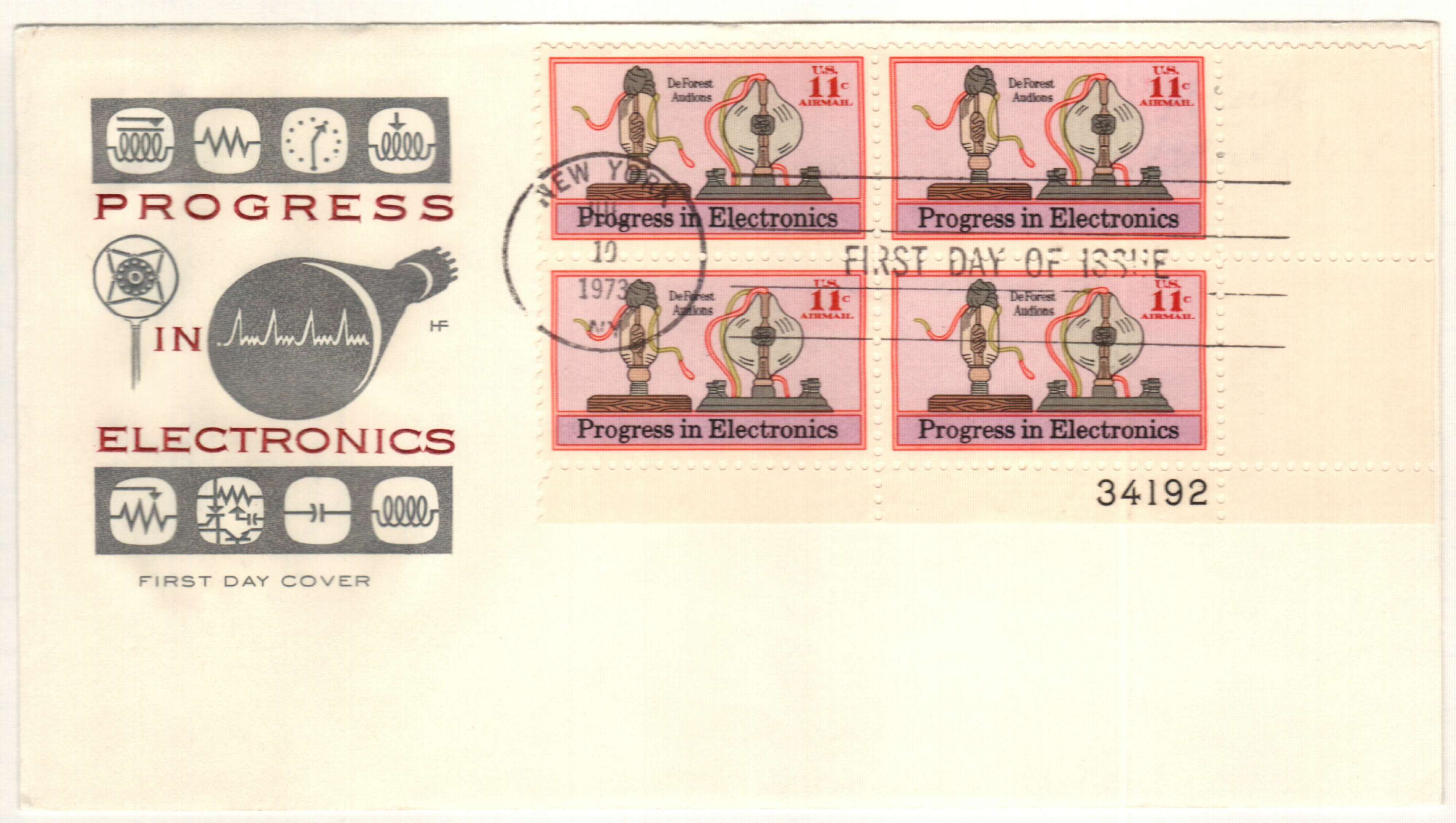 The Audion used De Forest's introduction of what he called a grid. It was a simple adjustment "a bent wire stuck between the two parts of the transmitter." But it improved performance and amplified sound much better than the previous transmitters. Interestingly, de Forest himself didn't completely understand his groundbreaking invention. His notes in the patent later proved to be partially incorrect, and he was famous for saying he "didn't know why it worked, it just worked."
The Audion used De Forest's introduction of what he called a grid. It was a simple adjustment "a bent wire stuck between the two parts of the transmitter." But it improved performance and amplified sound much better than the previous transmitters. Interestingly, de Forest himself didn't completely understand his groundbreaking invention. His notes in the patent later proved to be partially incorrect, and he was famous for saying he "didn't know why it worked, it just worked."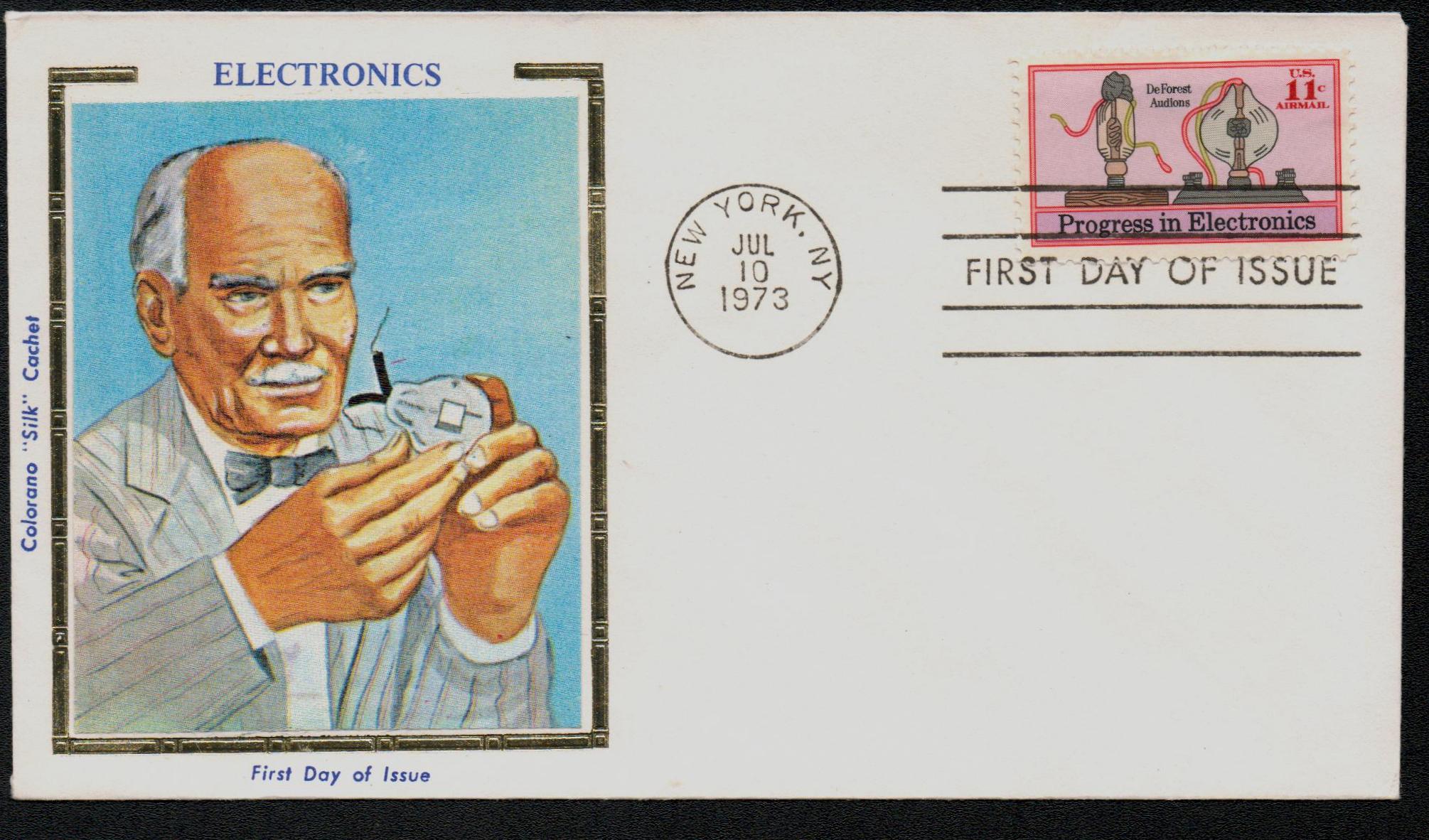
The Audion laid the groundwork for public radio broadcasting. De Forest later sold the rights to the Audion to RCA for $50,000. De Forest's work was also crucial to the development of adding sound to films.
Throughout his life, de Forest received more than 180 patents, but he frequently ran into legal disputes over many of these patents. He claimed he had made and then lost four fortunes, losing his fortunes to pay his legal fees. In his later years, he was unhappy with how his radio technology had been used for entertainment. He once said, "What have you done with my child, the radio broadcast? You have debased this child, dressed him in rags of ragtime, tatters of jive and boogie-woogie."
De Forest died on June 30, 1961. He considered the grid Audion to be his greatest invention. His work made long-distance telephone service, radio broadcasting, television, and many other technologies possible. For his contributions, he's sometimes called one of the founders of the "electronic age."
1973 11¢ DeForest Audion
Electronics Progress
First City: New York, New York
Quantity Issued: 58,705,000
Printed by: Bureau of Engraving and Printing
Printing Method: Lithographed, engraved (Giori)
Perforation: 11
Birth Of Lee De Forest
De Forest was descended from Jesse de Forest, who'd led a group of Walloon Huguenots from Europe in the 1600s. His father was a minister who hoped that his son would become a pastor, but he went to Yale's Sheffield Scientific School instead.
Early on de Forest wanted to become rich and famous and often sent his devices and puzzles to different companies, though this did little for his career. In college, his experiments often blew fuses, which caused blackouts and eventually got him expelled. He eventually returned and earned his doctorate in 1899.
 After college, de Forest worked at the Western Electric Company's telephone lab in Chicago, where he developed his first receiver and responders. After working a series of short-term jobs, he took a position as a night teacher so he could conduct experiments at the Armour Institute during the day. De Forest then went to New York to focus on his work with spark-coil transmitters.
After college, de Forest worked at the Western Electric Company's telephone lab in Chicago, where he developed his first receiver and responders. After working a series of short-term jobs, he took a position as a night teacher so he could conduct experiments at the Armour Institute during the day. De Forest then went to New York to focus on his work with spark-coil transmitters.With the aid of Abraham White, de Forest started his own company, American De Forest Wireless Telegraph. The company set up a spark transmitter on Wall Street and established stations in China that enabled journalists to report on the Russo-Japanese War. De Forest then won a gold medal for his radiotelegraph at the Louisiana Purchase Exposition in 1904. The company also built high-powered radiotelegraph stations in Florida, Panama, Cuba, and Puerto Rico.
 Due to conflicts with management, de Forest left the company in 1906 and formed Radio Telephone Company. He developed an arc radiotelephone during this time and made the first ship-to-shore transmissions by radiotelephone. The Navy ordered 26 of his devices for the Great White Fleet's around the world journey but removed them from the ships after their return because they were unreliable.
Due to conflicts with management, de Forest left the company in 1906 and formed Radio Telephone Company. He developed an arc radiotelephone during this time and made the first ship-to-shore transmissions by radiotelephone. The Navy ordered 26 of his devices for the Great White Fleet's around the world journey but removed them from the ships after their return because they were unreliable. De Forest's most famous invention was the Audion vacuum tube, a device for amplifying feeble electric currents. His invention resulted in the first radio broadcast in 1907, earning de Forest the name "Father of the Radio."
 The Audion used De Forest's introduction of what he called a grid. It was a simple adjustment "a bent wire stuck between the two parts of the transmitter." But it improved performance and amplified sound much better than the previous transmitters. Interestingly, de Forest himself didn't completely understand his groundbreaking invention. His notes in the patent later proved to be partially incorrect, and he was famous for saying he "didn't know why it worked, it just worked."
The Audion used De Forest's introduction of what he called a grid. It was a simple adjustment "a bent wire stuck between the two parts of the transmitter." But it improved performance and amplified sound much better than the previous transmitters. Interestingly, de Forest himself didn't completely understand his groundbreaking invention. His notes in the patent later proved to be partially incorrect, and he was famous for saying he "didn't know why it worked, it just worked."
The Audion laid the groundwork for public radio broadcasting. De Forest later sold the rights to the Audion to RCA for $50,000. De Forest's work was also crucial to the development of adding sound to films.
Throughout his life, de Forest received more than 180 patents, but he frequently ran into legal disputes over many of these patents. He claimed he had made and then lost four fortunes, losing his fortunes to pay his legal fees. In his later years, he was unhappy with how his radio technology had been used for entertainment. He once said, "What have you done with my child, the radio broadcast? You have debased this child, dressed him in rags of ragtime, tatters of jive and boogie-woogie."
De Forest died on June 30, 1961. He considered the grid Audion to be his greatest invention. His work made long-distance telephone service, radio broadcasting, television, and many other technologies possible. For his contributions, he's sometimes called one of the founders of the "electronic age."



